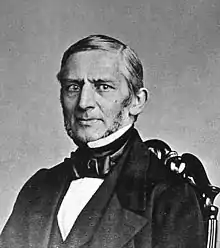
Adolf Repsold (31 August 1806 – 13 March 1871) was a German astronomical and scientific instrument maker, son of the astronomer and fireman Johann Georg Repsold. He established the company A. & G. Repsold along with his brother and it was continued by his son Johann Adolf Repsold under the name of A. Repsold & Söhne in Hamburg.
Repsold was born in Hamburg, the son of fire-brigade captain and astronomer Johann Georg Repsold who died in a fire in 1830 after which he took his father's place in the fire service. Along with his brother Georg Repsold (1804–1867), they continued their father's instrument business as A. & G. Repsold company specializing in the fabrication of astronomical and scientific instruments. Collaborations with Carl August Steinheil led to several innovations including a measuring graticule within the eyepiece. Repsold's instruments were widely in use in astronomical observatories across Europe and included the Oxford Heliometer. A universal (theodolite) instrument made by Repsold was used in the geodetic surveys of Friedrich Georg Wilhelm Struve.[1][2] Repsold made his son Johann Adolf (also known as Hans) a partner in 1858. Repsold left the company in 1867 to his sons Johann Adolf and Oscar. The company continued in existence until 1919 when it was shut down.[3][4]
References
- ↑ Pettersen, Bjørn Ragnvald; Müller, Jürgen (2009). "Small Instrument – Big Task. A Historical Account of how a Repsold Universal Instrument came to serve at the Arctic End of the Struve Geodetic Arc" (PDF). Zeitschrift für Geodäsie. 6: 348–357.
- ↑ Abbe, Cleveland (1867). "The repsold portable vertical circle". American Journal of Science. 128: 207–216. doi:10.2475/ajs.s2-43.128.207.
- ↑ Fréchet, J.; Rivera, L. (2012). "Horizontal pendulum development and the legacy of Ernst von Rebeur-Paschwitz". Journal of Seismology. 16 (2): 315–343. doi:10.1007/s10950-011-9272-5.
- ↑ Raposo, Pedro M. P. (2013). "Observatories, instruments and practices in motion: an astronomical journey in the nineteenth-century" (PDF). Journal of History of Science and Technology. 8: 69–104.